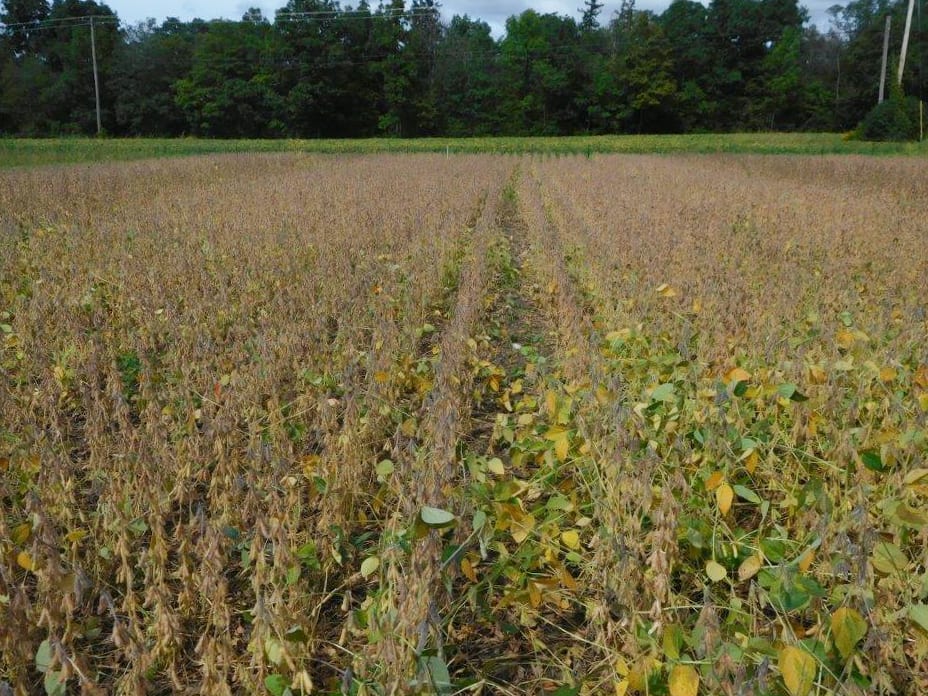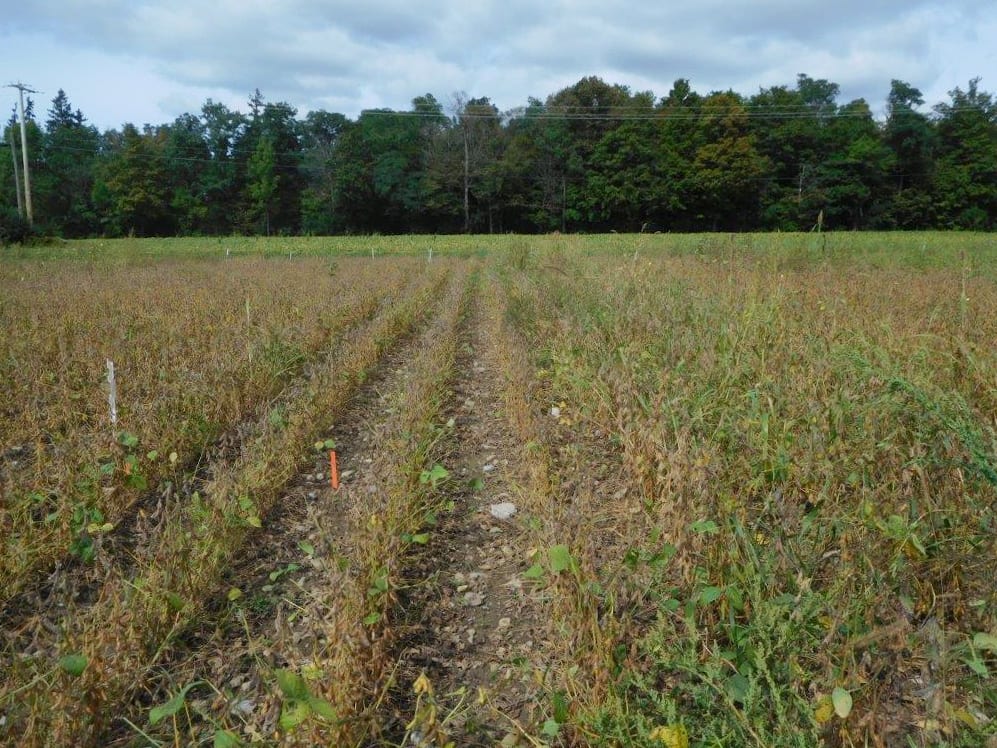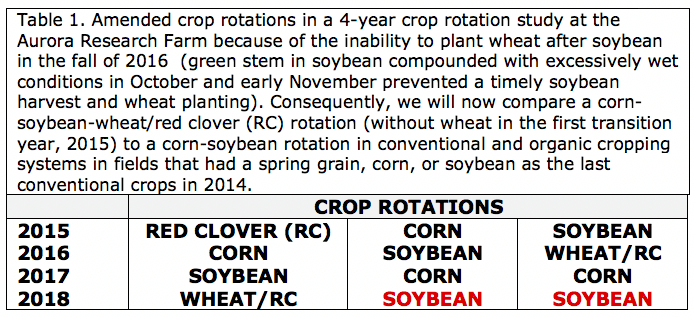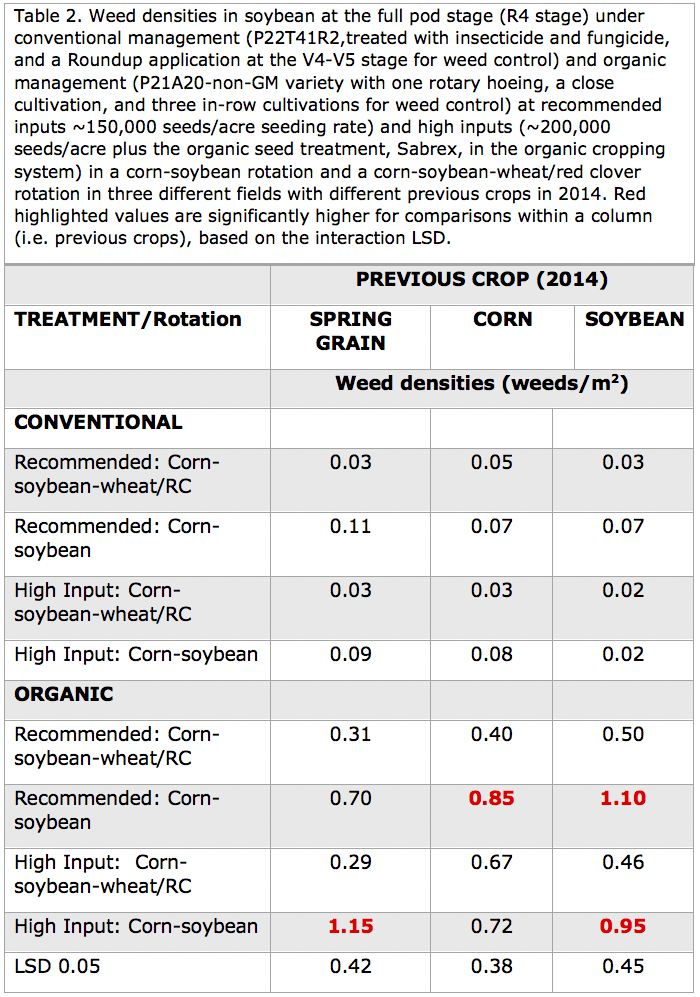Bill Cox and Eric Sandsted
We initiated a 4-year study at the Aurora Research Farm in 2015 to compare different sequences of the corn, soybean, and wheat/red clover rotation in conventional and organic cropping systems under recommended and high input management during the transition from conventional to an organic cropping system. We provided a detailed discussion of the various treatments and objectives of the study in a previous news article (https://blogs.cornell.edu/whatscroppingup/2015/07/23/emergence-early-v4-stage-and-final-plant-populations-v10-psnt-values-v4-and-weed-densities-v12-in-corn-under-conventional-and-organic-cropping-systems/). Unfortunately, we were unable to plant wheat after soybean in the fall of 2016 because green stem in soybean, compounded with very wet conditions in October and early November, delayed soybean harvest until November 9, too late for wheat planting. Consequently, corn followed soybean as well as wheat/red cover in 2017 so we are now comparing different sequences of the corn-soybean-wheat/red clover rotation with a corn-soybean rotation (Table 1). This article will focus on weed densities in soybean in 2018 (highlighted in red in Table 1) at the full pod stage (R4), the end of the critical weed-free period for soybean.
The fields were plowed on May 17 and then cultimulched on the morning of May 18, the day of planting. We used the White Air Seeder to plant the treated (insecticide/fungicide) GMO soybean variety, P22T41R2, and the non-treated, non-GMO variety, P21A20, at two seeding rates, ~150,000 (recommended input) and ~200,000 seeds/acre (high input). We also treated the non-GMO, P21A20, in the seed hopper with the organic seed treatment, Sabrex, in the high input treatment (high seeding rate). We used the typical 15” row spacing in conventional soybean and the typical 30” row spacing (for cultivation of weeds) in organic soybean. We rotary hoed the organic soybeans on May 29, followed by a close cultivation on June 14, and then three in-row cultivations (June 19, July 10, and July 26). We applied a single application of Roundup to conventional soybeans on June 20.
Conditions were very dry for the 2 months following planting (3.12 inches from May 17 until July 16). Consequently, weed densities were quite low through late July. Over the next 10-day period (July 17-27), however, 4.89 inches of precipitation were recorded at the Aurora Research Farm. Consequently, very robust weeds (velvet leaf, foxtail, and ragweed in particular) were visible in the organic plots when we took our weed counts on August 10 at the full pod stage (R4 stage), the end of the critical weed-free period in soybeans. Conditions remained relatively moist with 3.53 inches of rain in August and another 2.0 inches of rain during the first 2 weeks of September.

Weeds were almost non-existent in the conventional plots that received only a single application of Roundup (Table 2). This is the 4th consecutive year in soybeans where we applied a single application of Roundup for weed control and had almost complete control. Rotation and management inputs did not affect weed densities in conventional soybean (Table 2). The use of the moldboard plow in conjunction with a Roundup application about 5 weeks after planting has certainly been an excellent weed control combination for conventional soybean in this study (Photo 1).

Although weed densities were relatively low in organic soybeans (mostly less than 1.0 weed/m2, Table 2), the weeds were very robust (Photo 2). Undoubtedly, the very wet conditions from mid-July through mid-September provided excellent growing conditions for the late-emerging velvet leaf and ragweed. Unlike conventional soybean, rotation did affect weed densities in organic soybeans with higher weed densities in the corn-soybean rotation compared with the corn-soybean-wheat/red clover rotation in all three fields (spring grain, corn, and soybean fields in 2014). We also observed a rotation effect for weed densities in organic corn in 2017 (but not in conventional corn) with far fewer weeds in organic corn in the corn-soybean-wheat/red clover rotation compared to the corn-soybean rotation (https://blogs.cornell.edu/whatscroppingup/2017/08/10/wheatred-clover-provides-n-and-may-help-with-weed-control-in-the-organic-corn-soybean-wheatred-clover-rotation/). High seeding rates did not affect weed densities in organic soybean in 2018.
In conclusion, conventional soybean had virtually no weeds in 2018 for the 4th consecutive year when combing moldboard plowing with a single application of Roundup. In contrast, organic soybean had very robust weeds in 2018, which resulted in a somewhat trashy looking field, but weed densities were relatively low for the 4th consecutive year. The corn-soybean- wheat/red clover rotation had lower weed densities when compared to the corn-soybean rotation in organic soybean so the inclusion of wheat/red clover in the rotation appears essential to maintain weed densities at a manageable level in organic soybeans. The very wet conditions from about mid-July (R3 stage) through mid-September (R7 stage), however, may mitigate any potential yield losses in the corn-soybean compared to the corn-soybean-wheat/red clover rotation, despite ~ 2x higher weed density. High (~200,000 seeds/acre) compared to recommended seeding rates (~150,000 seeds/acre) did not reduce weed densities in organic soybean. Perhaps more emphasis should be placed on identifying the best crop rotations rather than high seeding rates for reducing weed densities in organic soybean in New York.



